"Rich cooking smells permeated the close space. The Cheesecakes Mrs. Goodfellow had prepared erarlier were cooling on one of the large wall racks. On another rested little tins of heart- and diamond-shaped Queen cakes, waiting to be prettily decorated later with fluffly sweet meringue icing, colorful nonpareils and fine sugar sand [ ...]
On one end of the wooden work table had set out crocks of fresh butter and cream, and some small bowls of flour, herbs and spices to make the chicken. At the other end sat earthenware dishes of butter and eggs, the box of powdered white sugar Hannah had prepared, and separated demijohns of white wine, brandy and rosewater for the lemon pudding."
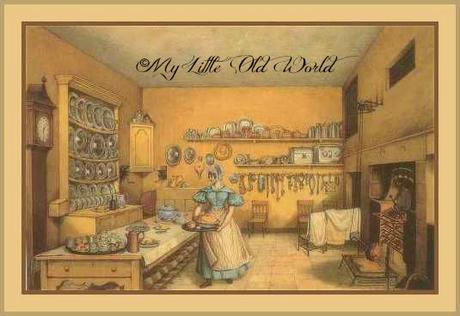
"Profumi di cottura ricchi permeavano il piccolo ambiente. I Cheesecakes che Mrs. Goodfellow aveva preparato in precedenza erano a raffreddare su di una delle grandi rastrelliere a muro. Su di un altra riposato piccole teglie con Queen cakes a forma di cuore o di diamante, in attesa di essere graziosamente decorate con della soffice dolce meringa, nonpareils colorate e bei 'sugar sand' in preparazione *[...]
Da un lato del piano di lavoro in legno aveva esposti cocci colmi burro fresco e panna, e alcune piccole ciotole di farina, erbe e spezie per preparare il pollo. All'altra estremità giacevano piatti di terracotta colmi di burro e uova, la scatola dello zucchero bianco a velo che Hannah aveva preparato, e piccole damigiane di vino bianco, grappa e acqua di rose per il Lemon Pudding".
Quest'oggi voglio presentarvi una donna realmente eccezionale, intraprendente, volitiva e capace di cui vi ho già fatto menzione parlandovi QUI di Miss Eliza Leslie e dei suoi cupcakes essendo stata costei di Miss Leslie la preziosa insegnante di cucina e, nello specifico, colei che istituì la prima scuola di cucina nella storia americana - con l'intenzione di educare al cucinare le fanciulle della classe medio-agiata - situata nella vivace città di Philadelphia dei primi anni del XIX°secolo.
Ma ella non fu solamente una sagace, esperta e pretenziosa insegnante, intenzionata a forgiare cuoche perfette, era molto, molto più di questo.
Procediamo però con ordine e sono certa che conoscendola rimarrete entusiasti nell'apprendere quante meravigliose cose una donna può essere in grado di fare e soprattutto quanto spirito d'intraprendenza recava con sé ed alimentasse il XIX°secolo, ovvero quella splendida epoca che iniziò con l'era Regency per concludersi con quella Vittoriana.
Il suo nome ?
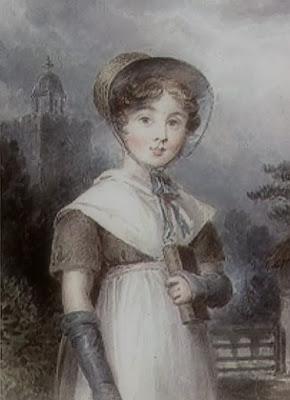
Little Girl in a Quaker Costume, Holding a Bible, by Isaac Pocock (1782-1854)
Elizabeth Baker e ra nata nel 1768, figlia di William and Ann Baker, nello stato del Maryland, in una comunità di cultura Quaker, quacchera; p robabilmente, anzi, senza alcun dubbio fu l'aver trovato marito all'esterno della comunità che la indusse a lasciare la famiglia di origine per crearsene una propria, ma ebbe la sfortuna di sposarsi tre volte e per ben tre volte, dopo pochi anni di matrimonio, di rimanere vedova e, quale vedova con due figlioli, dovette condurre la propria vita già da giovane donna.
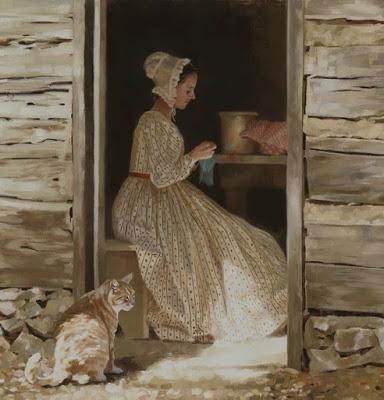
Il primo marito, di cognome Pearson, quasi certamente maestro pasticcere, la condusse a Philadelphia dove nel 1800 nacque Sarah, la prima figlia, e dove in prossimità del porto, esattamente in Dock Street, Mrs. Elizabeth Pearson gestiva un negozio di pasticceria;
rimasta vedova con ogni probabilità intorno al 1803 si risposò quasi subito con Robert Coane ed ebbe il secondo figlio, cui diedero il medesimo nome del padre, nel 1804.
Forse uomo di mare, Robert Coane fu dato disperso nel 1807 e nel 1808, quando ormai ella si stava avviando verso i quarant'anni di età, si maritò per una terza ed ultima volta con William Goodfellow, un orologiaio nato in Scozia, giunto a Philadelphia sul finire del secolo ed anche lui già vedovo da un paio di anni della prima moglie, il quale ahimè, le rimarrà accanto non più di 10 anni.
Ma la sua vita, vera, autentica, quella che la rese famosa, per Mrs. Goodfellow, stava per cominciare proprio e solamente allora.
Non so se avete notato il mio modo non del tutto certo di darvi notizie, perchè stiamo parlando di un passato un po' tanto lontano e non documentato per iscritto, come ci fa notare BECKY DIAMOND, autrice di un testo che mi ha letteralmente entusiasmato: ci ha fatte conoscere il post che feci su Eliza Leslie, in cui ella s'imbattè nel tentativo di reperire notizie e cercare di ricostruire la vita di Mrs. Goodfellow; dopo aver letto il mio post si mise in contatto con me proponendomi questa sua lettura, qualora ne fossi interessata ed immaginate la mia risposta.... l'unico libro scritto fin'ora su Mrs. Goodfellow, fondatrice della prima scuola di cucina nella storia americana, potevo non essere entusiasta di tutto ciò, e di leggere un testo che ella mi ha direttamente inviato con tanto di dedica e di bigliettino augurale ?
Ma del testo voglio parlarvi più tardi, proseguiamo con la descrizione di questo fantastico personaggio.
Nel 1810 il censimento che venne fatto a Philadelphia documentava:
[...] la casa che ella divideva con il marito William Goodfellow totalizzava undici membri. Oltre a William, Eliza ei suoi due figli, c'erano sette altri membri, tutte femmine di età compresa da quella della fanciullezza a quella adulta.
Almeno alcune di queste donne e ragazze probabilmente affiancavano Mrs. Goodfellow non solo nel negozio, ma anche nello svolgimento di tutte le funzioni necessarie per mantenere la sua casa. La lista dei compiti considerate entrambe le attività doveva essere senza fine: cucinare, pulire, fare commissioni, stoccaggio del fuoco, andare a prendere l'acqua, cucire e rammendare, oltre a prendere gli ordini per la pasticceria, chi lavorava nel negozio come magazziniere e teneva la contabilità ( quando rimarrà vedova per la terza volta sotto il suo tetto vivranno con lei ed i suoi figli altre sette persone tra cui tre uomini oltre il figlio Robert ).
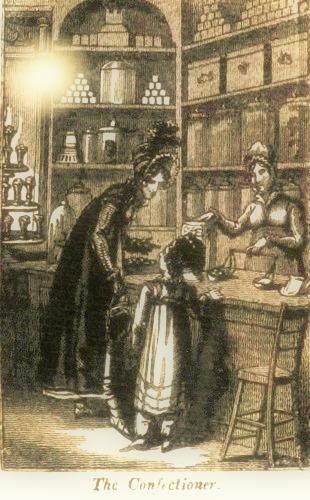
Certo, i proventi di un negozio non sono granchè rapportati alle persone che doveva sostentare anche se la pasticceria di Mrs.Goodfellow era situata in una zona strategica, vicino al porto dove quotidianamente venivano sbarcate merci fresche dalle colonie, dallo zucchero alla frutta tropicale - ananas, noci di cocco, banane -, agli agrumi che provenivano dalla Spagna per non parlare dell'enorme quantità di spezie di origine indiana - dalla cannella all'acqua di fiori d'arancio e di rose - e, pur non essendo l'unica della città, era quella che offriva i prodotti di gran lunga migliori, non solo per questo motivo ... non dobbiamo dimenticare infatti l'estrazione sociale e culturale di questa deliziosa signora: i Quackers, provenienti dalle isole britanniche, recarono con sé nel nuovo continente le antiche ricette di famiglia, spesso di derivazione francese ( dove le scuole di cucina esistevano già dal XVIII secolo ) e rielaborate, tramandate di madre in figlia come un patrimonio da conservare.

William Page Atkinson Wells (1872-1923) , Landscape
In effetti di questa cultura si sa molto poco, mi riferisco soprattutto a noi italiani, e a tale proposito mi appresto a citare un altro passo dal testo di BECKY DIAMOND :
Tra i Quackers americani, quelli di Philadelphia erano soprattutto progressisti per quanto in termini di apprendimento hanno fornito. Poco dopo la fondazione della città, William Penn emanò uno statuto per fornire la città di una scuola pubblica la cui fondazione sopravvive ancora oggi nella William Penn Charter School e nella Friends Select School: "a tutti i bambini, all'interno della provincia, dell'età di dodici anni, deve essere insegnato qualche mestiere utile o affinata una qualche abilità, alla fine nessuno può essere inattivo, poiché se i poveri possono lavorare per vivere, al ricco, se dovesse diventar povero, non rimarrebbe neppure la possibilità di scegliere. " 3
Mrs.Goodfellow godeva inoltre di ottimi rapporti con le comunità di Quackers che vivevano nel circondario di Philadelphia, con cui ella era rimasta in stretto contatto, i quali le fornivano quotidianamente merce fresca proveniente dalle loro ampie fattorie e questo, coniugato alle sue conoscenze, a quello che le insegnò il primo marito, di certo mastro pasticcere, e a quanto detto sopra circa la forniture provenienti dall'estero fecero sì che quella di Mrs.Goodfellow divenisse la pasticceria più ricercata, ottima fornitrice per banchetti, 'tea parties', cene ufficiali eccetera.
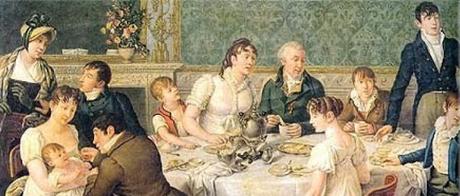
Regency Tea Party, autore sconosciuto
A partire dal 1835 il figlio Robert si mise in affari con la madre e la pasticceria si ampliò, mutò sede per prendere collocazione al numero 91 della elegante South Sixth Street e venne rinominata
Eliza Goodfellow ha preso suo figlio nella sua attività, e dopo aver ampliato notevolmente il loro edificio sono ora pronti a fornire in qualsiasi quantità, gelato, gelatina, blanche mange , e pasticcini di ogni sorta. Inoltre, cesti di caramelle, piramidi, dolciumi e frutta . 4
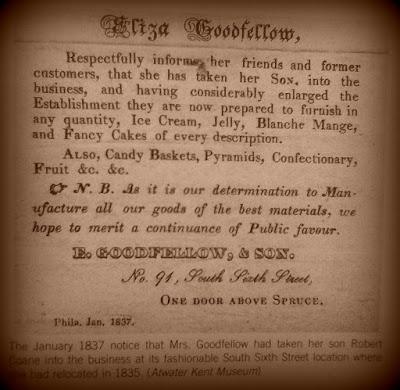
Annuncio del gennaio 1837 che rende pubblici la riqualificazione ed il trasferimento dell'attività avvenuti nel 1835
Ma Mrs. Goodfellow, che mai scrisse un libro sulla sua arte, voleva tramandare il suo sapere a più giovani donne possibile e fu così che decise di dare vita alla primissima scuola di cucina in America: sotto il negozio, nel seminterrato, areato da ampie finestre rasenti il soffitto, nella cucina dove ella preparava i suoi prelibati dolci, accoglieva fanciulle ancora da maritare o vedove che, magari in cerca di lavoro, avevano deciso di specializzarsi come cuoche nella speranza di trovare con facilità un'occupazione che fornisse loro il denaro necessario per mantenere i propri orfani.
Durante gli inizi del XIX secolo Philadelphia era infatti la 'capitale' americana del benessere e lo rimarrà fino alla guerra di secessione, popolata da famiglie facoltose di nobili od aristocratiche origini che di tale benessere erano la più sicura garanzia.
Alle proprie alunne ella volle insegnare ogni cosa che avesse a che fare con l'arte del cucinare, dalle piccole malizie per preparare dolci perfetti ( ella mai separò il bianco dal tuorlo dell'uovo per la preparazione di dolci montando entrambi energicamente con attrezzi di legno in terrine in modo che la temperatura si mantenesse costante, raccomandava di usare, anche negli impasti, le mani il meno possibile per non influire con la loro temperatura nelle preparazioni, e di aiutarsi piuttosto con una forchetta, di intuire la temperatura adatta per i dolci aprendo lo sportello del forno a legna e mettendovi di fronte le mani: se contando fino a dodici vi si resisteva, la temperatura era quella adatta, mentre per il pollo bisognava contare fino a venti, etc.) come apparecchiare correttamente la tavola, ovvero come disporre i piatti e le posate, le saliere che andavano poste ogni due piatti, etc., a come mantenere l'educazione una volta seduti a tavola, suggerendo persino quali fossero gli argomenti adeguati da trattare nella conversazione per non sfigurare e dare di sé un'ottima impressione sull'uditorio; se invece il loro destino le avesse volute cameriere piuttosto che mogli e padrone di casa, altre erano le regole da imparare: in un pasto in cui vi fosse un piatto di carne esso andava posto di fronte al padrone di casa che sarebbe stato seduto dall'altro capo del tavolo rispetto alla consorte, se vi era una zuppa da servire si consegnava la zuppiera alla Lady che provvedeva da seduta a servire tutti i commensali; ogni vassoio doveva recare non più di una portata alla volta e se solo uno era il servitore a tavola si doveva mettere in piedi accanto al Gentleman, se due una accanto al Gentleman ed una accanto alla Lady, se quattro, uno per angolo del tavolo.
Tutto ciò, però, non lo sappiamo direttamente da Mrs.Goodfellow, ma lo apprendiamo leggendo le pubblicazioni di Miss Eliza Leslie

che probabilmente fu una delle sue più attente scolare che prese nota del seppur minimo dettaglio che veniva mostrato od insegnato:
Seventy-Five Receipts for Pastry, Cakes, and Sweetmeats, (1828) 1836;
1832;
Miss Leslie's Behavior Book ,1834;
Directions for Cookery, in its Various Branches , (1837) 1844;
Miss Leslie's Lady's New Receipt-Book , (1840) 1850;
,1847;
The Lady's Receipt-Book: A Useful Companion for Large or Small Families ,1847;
Miss Leslie's Lady's New Receipt-Book ,1850;
,1852;
,1854;
,1857.
New Cookery Book dell'alimentazione William Woys Weaver dobbiamo ringraziare questa deliziosa signora se tale dolce esiste; si sa che il Lemon Pudding era una delle specialità della sua pasticceria e che la crostata al limone veniva spalmata con esso prima di essere posta in forno ( gli inglesi usavano non il Lemon Pudding bensì il Lemon Curd ) poi a fine cottura veniva aggiunto il meringaggio e rimessa la teglia in prossimità di una fonte di calore per farlo leggermente rassodare e dorare, ma non brunire.
Ed infine, quasi come fosse una sorpresa ed effettivamente come tale ci coglie, ci viene svelato una sorta di segreto, quello che vuole che la Lemon Meringue Pie, ovvero la crostata al limone con meringaggio sopra, sia una invenzione di Mrs.Goodfellow: stando agli studi condotti dallo storico Ci suggerisce Eliza Leslie che Mrs.Goodfellow consigliava di mettere il meringaggio di finitura in due tempi per farlo ascuigare bene, gradatamente e senza che si crepi in superficie.
Tratta dal primo libro pubblicato da Miss Leslie nel 1828 ecco a voi la famosa ricetta del
Un limone, con una crosta sottile liscia.
Un etto di zucchero bianco in polvere.
Un etto di burro lavato fresco.
Una tabella-cucchiaio di vino bianco e brandy, misto.
Un tè-cucchiaio di acqua di rose.
Cinque etti di farina setacciata, e un quarto di libbra di burro fresco, per la pasta [crosta].
Prima di usare i limoni per qualsiasi scopo, sempre rotolateli per un po' con la mano su di un tavolo. Questo li farà produrre una maggiore quantità di succo. 5
Dopo cinque anni l'attività di Mrs. E. Goodfellow & Son mutò per un'ultima volta sede per spostarsi nella elegantissima Washinghton Square, in un palazzo in mattoni a tre piani ( al piano terra vi era il negozio ed un salone per gustare i dolci ed i gelati che erano divenuti un'altra specialità della ditta, al primo piano vi era un altro salone con un ampia balconata, al secondo presumibilmente erano collocate le stanze dei proprietari mentre a quello superiore, mansardato, quelle dei dipendenti ) " E. Goodfellow & Son's Confectionary, Pastry and Fancy Cake Bakery " recava scritta l'insegna che sovrastava la porta d'ingresso ed il successo era ormai del tutto consolidato.
Facendo un discorso generale trent'anni durò questa attività suddivisa tra negozio ed l'insegnamento, anzi è presumibile pensare che Mrs Goodfellow, con l'avanzare dell'età, abbia lasciato in negozio il figlio con alcuni commessi e che lei si sia occupata solamente della scuola;
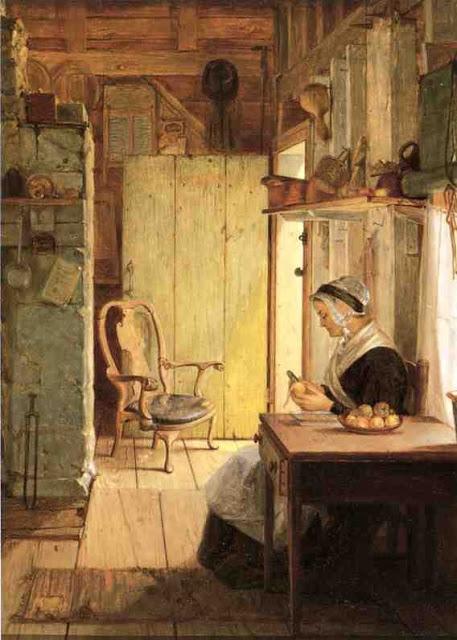
Kitchen Interior by Thomas Hicks,1865
una volta scomparsa questa donna dall'intraprendenza, solerzia ed industriosità unica, all'età di 83 anni nel 1851, solamente per alcuni anni il figlio prosegui l'attività perché già così ben avviata, ma poi decise di darsi alla politica e cessò di fare il pasticcere.
Questo non significa però che il sapere di Mrs.Goodfellow sia andato perduto, anzi, oltre ad Eliza Leslie altri suoi alunni pubblicarono su riviste per la casa ( per esempio sul Godey's Lady's Book ) o su libri di cucina che videro la luce sul finire del secolo od addirittura nei primi del novecento, ricette che recavano la sua firma e molte delle cose che facciamo usualmente noi oggi nel preparare i nostri dolci o quelle che consideriamo ricette di famiglia sono con ogni probabilità di sua provenienza ... ma ci pensate !
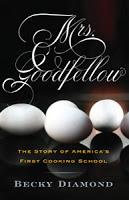
Ed infine lasciate che vi presenti questo libro che si legge con una letizia tale che una volta cominciato si fatica a riporlo per proseguire la lettura in un altro momento, lo si vorrebbe leggere tutto di un fiato.
L'autrice, con il fare indagatore proprio dello storico, cerca di reperire più notizie possibili per ricostruire questo personaggio che ha lasciato una grande impronta di sé nella storia non essendo sicuramente riconosciuto quanto meriterebbe, ed immagina una sua giornata ideale, vissuta vivacemente tra cucina, negozio ed insegnamento, facendo puntualmente riferimento al retroterra storico-culturale dell'America di allora e ponendo in appendice alcune delle ricette originali di Mrs.Goodfellow ... non è qualificabile come un libro di cucina, assolutamente, lo è più quale libro storiografico che si lascia leggere con la leggerezza e l'entusiasmo che solo un appassionante romanzo può suscitare.
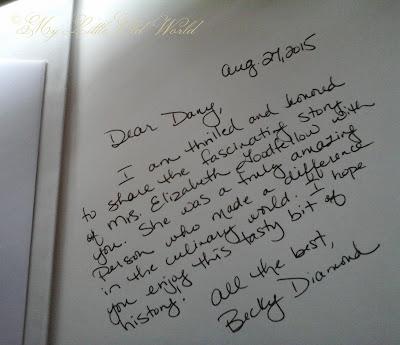
GRAZIE DI CUORE BECKY, HO LETTO UN LIBRO PIACEVOLISSIMO, INTERESSANTE, SCRITTO CON TANTO AMORE, CHE SONO ORGOGLIOSA DI POSSEDERE, HO MESSO INSIEME UN POST CON ESTREMO ENTUSIASMO ED HO ACQUISTATO UNA DOLCISSIMA, AMABILE NUOVA AMICA .... GRAZIE PER TUTTO CIO', QUESTO POST LO DEDICO A TE E AL TUO BUON CUORE.
E come sempre grazie ad ognuno di voi, per l'interesse e l'affetto con cui mi dedicate il vostro tempo,
grazie con tutto il cuore,
a presto


Bibliografia:
Becky Libourel Diamond, Mrs.Goodfellow - THE STORY OF AMERICA'S FIRST COOKING SCHOOL, Westholme Publishing, United States of America, 2012;
Eliza Leslie, Seventy-Five Receipts for Pastry, Cakes, and Sweetmeats, (1828) 1836.
* con questo termine venivano indicati i depositi zuccherini che compaiono sul fondo di un contenitore che sia stato colmato di linfa d'acero quando la concentrazione di zucchero raggiungeva il 66-67%.
Tale sostanza doveva essere filtrata per completare il processo di zuccheraggio dello sciroppo d'acero.

"Rich cooking smells permeated the close space. The Cheesecakes Mrs. Goodfellow had prepared erarlier were cooling on one of the large wall racks. On another rested little tins of heart- and diamond-shaped Queen cakes, waiting to be prettily decorated later with fluffly sweet meringue icing, colorful nonpareils and fine sugar sand * [ ...]
On one end of the wooden work table had set out crocks of fresh butter and cream, and some small bowls of flour, herbs and spices to make the chicken. At the other end sat earthenware dishes of butter and eggs, the box of powdered white sugar Hannah had prepared, and separated demijohns of white wine, brandy and rosewater for the lemon pudding."
Elizabeth Baker was born in 1768, daughter of William and Ann Baker, in the state of Maryland, in a community of Quaker culture; probably, in fact, without any doubt, it was the husband she had found outside the community that made her leave her family of origin to crearsene one of her own, but had the misfortune to marry three times and for three times, after a few years of marriage, to become widow, and, as a widow with two children, she had to live her life even as a young woman.Today I want to introduce you a truly exceptional woman, resourceful, strong-willed and capable whom I have already mentioned telling you HERE about Miss Eliza Leslie and her cupcakes since she was Miss Leslie's precious cooking teacher and, specifically, the one who established the first cooking school in America - with the intention of educating to cooking the girls belonging to the middle-wealthy class - located in the vibrant city of Philadelphia during the early XIXth century.
But she wasn't only a shrewd, experienced and pretentious teacher, determined to forge perfect cooks, she was much, much more than this.
But let's proceed with order and I am sure you'll be thrilled to learn of knowing how many wonderful things a woman may be able to do and especially what an enterprising spirit brought with it and nourished the XIXth century, that is the wonderful era which began with the Regency period and was to end with the Victorian one.
Her name ?
- picture 2 - Little Girl in a Quaker Costume, Holding a Bible, by Isaac Pocock (1782-1854)
[...] the household she shared with husband William Goodfellow totaled eleven members. In addition to William , Eliza and her two children, there were seven other members, all females ranging in age from children to adults.
Of course, the earnings coming from a store are not enough compared to the number of persons it had to sustain even if the pastry of Mrs.Goodfellow was located in a strategic area, close to the port where they were unloaded daily fresh goods from the colonies, from sugar to tropical fruits - pineapple , coconuts, bananas - citrus coming from Spain for not to mention the enormous amount of spices of Indian origin - from cinnamon to the water of orange blossom and the rose water - and, although it wasn't the only one of the city, it was the one offering the products of the much better quality and taste and not only for this reason ... in fact we mustn't forget the social and cultural background of this lovely lady: the Quackers, coming from the British Isles, brought with them to the New World their old family recipes, often of French roots (where the cooking schools existed since the XVIIIth century) and reworked, handed down from mother to daughter as a heritage to be preserved.
At least some of these women and girls probably assisted Mrs. Goodfellow not only in the shop, but also in performing all the duties required to maintain her home. The list of tasks between both must have been endless: cooking, cleaning, running errands, stocking the fire, fetching water,sewing and mending, as well as taking pastry orders, working in the shop as storekeeper and bookkeping, just to name a few.
Since 1835 her son Robert went into business with her and the confictioner expanded, changed seat to take place at number 91 in the elegant South Sixth Street and was renamed (When she'll become a widow for the third time under her roof she will host, with her and her children and seven others girls also three men over her son Robert). In 1810 the census which was made in Philadelphia documented:
Her first husband, surnamed Pearson, almost certainly pastry chef, took her to Philadelphia in 1800 where Sarah, her first child, was born, and where, close to the harbor, just in Dock Street, Mrs. Elizabeth Pearson ran a pastry shop; widowed probably around 1803 she remarried almost immediately with Robert Coane and had a second child, who was named Robert after his father, in 1804.
Perhaps a seaman, Robert Coane was given lost at sea in 1807 - 1808 when she was heading toward the forty years of age, and got married for a third and final time with William Goodfellow, a watchmaker born in Scotland, came to Philadelphia at the end of the century and he also a widower for a couple of years of his first wife, who, alas, will remain by her side no more than 10 years.
But her own true, authentic life, the one which made her famous, Mrs. Goodfellow, was about to begin it only then.
who was probably one of her most attentive schoolgirls taking note of the slightest detail that was shown or taught:
I do not know if you noticed the way I do express myself, giving you news quite uncertain, because we're talking about such a long time ago not documented in writing, as
BECKY DIAMOND, author of a text that I really excited about, point out: the post I did on Eliza Leslie made know us, because when she worked in an attempt to find news and try to reconstruct the life of Mrs. Goodfellow she knew Eliza Leslie too, of course; after reading my post she got in touch with me proposing me the reading of her book, if I was interested in it ... and imagine my response .... so far the only book written on Mrs. Goodfellow, founder of the first cooking school in American history, couldn't i be excited about this, and to read a text that she sent me directly with a dedication and auspicious note just for me ?
But about the text I want to talk to you later, let's go on with the description of this fantastic character.
- picture 5 - William Page Atkinson Wells (1872-1923), Landscape
In effect we know very little about this amazing culture, I am referring especially to us Italians, and in this regard I am going to quote another passage from the lovely BECKY DIAMOND 's book:
Among the Quakers in America, those in Philadelphia were especially progressive in terms of the learning they provided. Shortly after the city's founding, William Penn granted a charter to provide a public school the foundation of which still survives in the William Penn Charter School and the Friends Select School: "all children, within the province, of the age of twelve years, shall be taughta some useful trade or skill, to the end none may be idle, but the poor may work to live, and the rich, if they become poor, may not want. "
Mrs.Goodfellow also enjoyed good relations with the community of Quakers who lived in the district of Philadelphia, with whom she had remained in close contact, which they provided daily fresh goods coming from the large farms and theirs, and it, together with her knowledge and whatshe was taught from her first husband, certainly master confectioner, and what has been said above about the supplies from abroad meant that Mrs.Goodfellow deserved the good reputation she earned and became the most sought after pastry, excellent supplier banquet, 'tea parties', official dinners etc.
Eliza Goodfellow has taken her son into her business, and having considerably enlarged the establishment they are now prepared to furnish in any quantity, ice cream, jelly, blanche mange, and fancy cakes of every descriptions. Also, candy baskets, pyramids, confectioeary and fruit .
- picture 7 - Announcement dating back to January 1837 that makes public the retraining and the transfer which occurred in 1835
But Mrs. Goodfellow, who never wrote a book about her art, wanted to pass on her knowledge to as many younger women as possible, and so it was that she decided to give life to the very first cooking school in America: under the store, in the basement, ventilated by large windows flush with the ceiling, in that which was the kitchen where she prepared her delicious desserts, she welcomed girls still to marry or widows, perhaps in search of work, who decided to specialize as cooks hoping to quickly find a job which would provide them the money needed to keep their orphans.
During the early nineteenth century, Philadelphia was in fact the 'capital' of the American welfare and will remain so until the Civil War, inhabited by wealthy families of noble or aristocratic origins which of this prosperity were the surest guarantee.
To her pupils she wanted to teach everything that had to do with the art of cooking, from small tricks to prepare perfect cakes (she never separated the white from the yolk of the eggs to make desserts mounting vigorously both of them with wood tools inside bowls so that the temperature would have remain constant, she recommended to use, even in the dough, hands as little as possible not to affect the preparation with their temperature and to help themselves rather with a fork, to sense the temperature suitable for sweets opening the door of the oven and putting their hands in front: if counting up to twelve they resisted, the temperature was the right one, while for the chicken, for example,it was necessary to count to twenty, etc.), how to set the table correctly, or how to arrange the dishes and cutlery, salt shakers that had to be placed every two plates, etc., in keeping education once seated at the table, even suggesting which were the appropriate topics to be discussed in the conversation not to deface and to give of them an excellent impression on the audience; but if their fate had wanted them to be waiter rather than wives of a rich landlord, there were other rules to learn: if a meal included a dish of meat it had to be in front of the landlord that would be sitting by the other side of the table than his wife, if there was to be served a soup the bowl had to be placed in front of the lady who would have provided to serve all the guests, just sitting, by herself; each tray should contain no more than one course at a time and if only one was the servant at the table, he had to stand up next to the Gentleman, if two one had to stay by the side of the Gentleman and one by that of the Lady, if four, one in correspondence of each corner of the table.
However, we don't know all this, and much more, directly from Mrs.Goodfellow, but we learn it by reading the publications of Miss Eliza Leslie
Seventy-Five Receipts for Pastry, Cakes, and Sweetmeats, (1828) 1836;
1832;
Miss Leslie's Behavior Book ,1834;
Directions for Cookery, in its Various Branches , (1837) 1844;
Miss Leslie's Lady's New Receipt-Book , (1840) 1850;
,1847;
The Lady's Receipt-Book: A Useful Companion for Large or Small Families ,1847;
Miss Leslie's Lady's New Receipt-Book ,1850;
,1852;
,1854;
,1857.
New Cookery Book
Eliza Leslie suggests that Mrs.Goodfellow advised to put the finishing of meringue in two intervals as to let it dry very well, gradually, for not to have it too soft or without any cracks on its surface.
And finally, almost like a surprise and actually like this it catches us, almost at the end of the book, there is revealed a kind of secret, which wants the Lemon Meringue Pie, or the lemon tart with a layer of meringue above, is an invention of Mrs.Goodfellow: according to the studies conducted by the historian William Woys Weaver thanks to this lovely lady today we do have such a sweet; we know that the Lemon Pudding was one of the specialties of her pastry and that the lemon tart was smeared with it before being placed into the oven ( the British don't used-use the Lemon Pudding but the Lemon Curd ); then after cooking and cooling the baking tin it was added the meringue and throw the pan in the vicinity of a heat source to make it firm and slightly browned, but not too brown. Is the first book published in 1828 by Miss Leslie there is this famous recipe
MRS.GOODFELLOW'S LEMON PUDDING:
One lemon, with a smooth thin rind.
A quarter pound of powdered white sugar.
A quarter pound of fresh butter-washed.
A table-spoonful of white wine and brandy, mixed.
A tea-spoonful of rose-water.
Five ounces of sifted flour, and a quarter of a pound of fresh butter, for the paste [crust].
Before using lemons for any purpose, always roll them awhile with your hand on a table. This will cause them to yield a larger quantity of juice. 5
After five years Mrs.E. Goodfellow & Son moved one more time in the elegant Washinghton Square, in a brick building with three floors ( in the ground floor there was the shop and a saloon where enjoy sweets and ice creams that had become another specialty of the 'house', on the first floor there was another room with a large balcony, on the second presumably were placed the rooms of the owners while at the upper, in the attic, those of the employees ) E. Goodfellow & Son's Confectionary, Pastry and Fancy Cake Bakery bore written the sign that hung over the front door and the success was now fully consolidated.
Taking a general discussion, it lasted thirty years this joint activity in the shop and the teaching, indeed it is likely to think that Mrs. Goodfellow, with the age, left her son in the store with some committed and that she took care only of the school;
- picture 9 - Kitchen Interior by Thomas Hicks, 1865
once this woman, from the unique initiative, diligence and industriousness, expired at the age of 83 in 1851, only for a few years her son went on the business because already so well established, but then he decided to devote himself to politics and ceased to make the pastry chef.
This doesn't mean, however, that Mrs.Goodfellow's knowledge has been lost, in fact, in addition to Eliza Leslie other pupils of hers published in journals for the home (for example on Godey's Lady's Book) or cookbooks which will be publish at the end of century or even in the early XXth century, recipes bearing her signature, and lots of the things that we usually do today to prepare our desserts or those we consider family recipes are probably coming from her ... but do you think about it ?!?
- cover on the left -And finally, let me present you this book which you read with a joy that once you get started it's hard to put it down for going on reading it in another moment, you would want to read it all in one breath.
The author, with just the historian's inquiring doing, tries to get as many informations as possible to rebuild this character that has left a great mark of herself in history ogf cooking, definitely not recognized as it deserves, and imagines one ideal day of hers, vividly lived between kitchen, shop and teaching, making timely reference to the historical and cultural background of the America of that time and putting in the appendix some of the original recipes of Mrs.Goodfellow ... it's not a cookbook, absolutely, it is rather an historiographical book that can be read with the lightness and the enthusiasm which an exciting novel gives rise to.
THANK YOU BECKY, I READ A PLEASANT, INTERESTING AND WRITTEN WITH LOTS OF LOVE BOOK I'M PROUD TO HAVE IN MY HOME, I PUT TOGETHER A POST WITH FAR ENTHUSIASM AND I 'VE GOT A FAR TOO SWEET NEW FRIEND .... THANKS FOR EVERYTHING, THIS POST IS DEDICATED TO YOU AND TO YOUR GOOD HEART.
And as usual, thanks to each of you, for the interest and the affection with which you dedicate your time to me, thank you with all my heart,
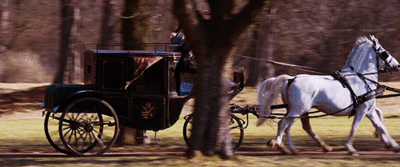

Bibliografia:
Becky Libourel Diamond, Mrs.Goodfellow - THE STORY OF AMERICA'S FIRST COOKING SCHOOL, Westholme Publishing, United States of America, 2012;
Eliza Leslie, Seventy-Five Receipts for Pastry, Cakes, and Sweetmeats, (1828) 1836.
By this term they were indicated the sugary deposits that appeared on the bottom of a container which has been filled with maple sap when the sugar concentration reached the 66-67%.
This substance had to be filtered to complete the process of sugaring the maple syrup.


